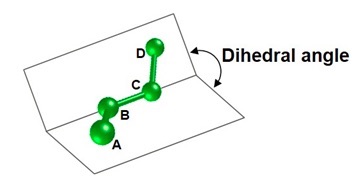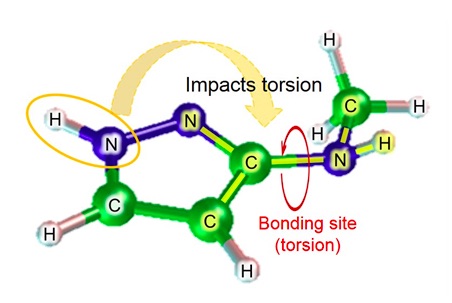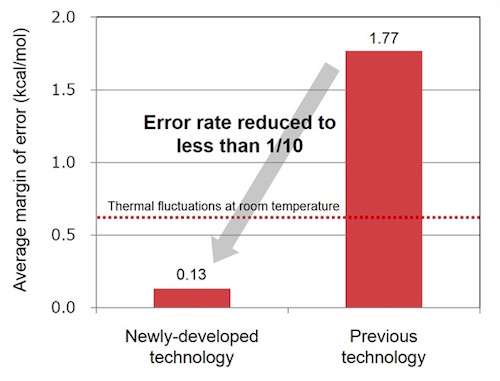|
|
|
|
|
|
| Estimated error rate of parameters, which give a rough indication of efficacy, below one tenth that of previous technology |
TOKYO, May 7, 2018 - (JCN Newswire) - Fujitsu Laboratories Ltd. and Fujitsu Limited today announced the development of molecular simulation technology for drug discovery that can accurately estimate binding affinity, which represents the degree to which proteins that can cause diseases (target proteins) bind to chemical substances that could become candidate drugs. In the process of drug discovery, there is a demand for accurate prediction of the binding affinity between target proteins and chemical substances, which offers a rough estimate of a drug's efficacy. Molecular simulation technology has been widely used in the past as a method of predicting binding affinity, calculating the approximate forces that arise between atoms in molecules using Newtonian mechanics. The problem with this method, however, remains that the low degree accuracy of its estimation of the most important parameters-the degree of torsion at the binding sites. This means that the accuracy of its estimation of the overall binding affinity is also poor. Now, Fujitsu Laboratories has developed molecular simulation technology that estimates the degree of torsion in a chemical substance, which is directly connected to the predicted binding affinity. The new technology not only takes into account the bonding location where the torsion will occur, but also the impact of neighboring atoms. Fujitsu Laboratories evaluated this technology for 190 types of chemical substances, comparing the results with correct results arrived at from first principles calculation(1) and then evaluating the error rate. Upon doing so, it was able to confirm that the error rate in the estimate of the degree of torsion was, on average, one-tenth that of previous technology. It is anticipated that the use of this new technology in IT-based drug discovery, with its ability to accurately estimate the binding affinity of targeted proteins and chemical substances, offers the potential for groundbreaking new drug discovery efforts that could not be achieved with previous approaches. Fujitsu Laboratories plans to include this technology in a new IT-based drug discovery service offered by Fujitsu Limited.
 | | Figure 1: Dihedral angle (the angle formed by the plane created by atoms A, B, and C, and the plane created by atoms B, C, and D) |
 | | Figure 2: Example of molecular structure: 3-(methylamino) pyrazole |
 | | Figure 3: Evaluating the performance of dihedral angle parameter values using 190 types of chemical compound structures |
Development Background
The discovery of new drugs requires significant expenses and timeframes that can be measured in decades, leading to a global search for new methods of discovering drugs. One of the methods that has received considerable interest is IT-based drug discovery, a new drug discovery method using computers that makes it possible to create chemical substances as candidates for novel drugs with a high probability of success. IT-based drug discovery has become a focal point for expectations as a groundbreaking technology for the creation of new drugs, because unlike previous methods of trial and error, in which chemical substances are repeatedly created and tested, this approach makes it possible to virtually design chemical substances and estimate their effects.
Issues
The effects of a chemical substance as a drug are expressed when the chemical substance binds to a target protein. When the chemical substance binds to the target protein, it can change its shape in line with that of the target protein. The degree of deformation, namely, the parameters that indicate the extent of this shape change, is directly connected to the binding affinity of the substance and the protein, and gives a rough idea of its effect as a drug. Given this, there is a strong demand for the ability to accurately predict this value. To calculate the degree of deformation of a chemical substance, there are methods based on quantum mechanics and methods based on Newtonian mechanics. Quantum-mechanics based first principles calculation enables extremely accurate calculations, resolving the states of electrons from the types and positions of the atoms involved. On the other hand, however, the ability of first principles to perform exacting calculations necessarily leads to massive time required to complete the calculations. In order to simulate the degree of deformation for numerous chemical substances, time required is in the order of years, making this method impractical. On the other hand, approximate calculations based on molecular simulations are extremely fast, using Newtonian mechanics to calculate the forces between the atoms within the molecules, and can even handle large molecules like proteins quite easily. Consequently, this method is widely used. With Newtonian mechanics, the forces between the atoms are expressed in the following manner:
1. As a force that depends on the distance between two atoms bonded to each other
2. A force that relies on the angles between three atoms bonded to each other
3. A force that relies on the degree of torsion in the bond, and
4. A force that relies on the distance between atoms that are not bonded.
Among these, when a chemical substance is bound to a target protein, the degree of torsion of the bond represents the important degree of deformation. With existing technology, however, the accuracy of the estimation of the dihedral angle (figure 1) parameter, which is necessary to calculate the degree of torsion of the bond, is quite low, resulting in the problem of low accuracy in the estimation of the affinity of the bond in the simulation.
http://www.acnnewswire.com/topimg/Low_Fujitsu5718Fig1.jpg
Figure 1: Dihedral angle (the angle formed by the plane created by atoms A, B, and C, and the plane created by atoms B, C, and D)
About the Newly Developed Technology
Fujitsu Laboratories has been developing molecular simulation technology for more than ten years. Now, using the knowledge it obtained through previous efforts, Fujitsu Laboratories has developed a molecular simulation technology that can estimate the dihedral angle parameter by taking into consideration the impact of atoms near the bond. Existing technology estimates the dihedral angle parameter based on a total of four atoms-the two atoms in the relevant bond, and the other atoms each of those atoms was bonded to. Depending on the structure of the molecule, however, there are cases where atoms beyond those four could have a significant impact, and in those cases, the margin of error of the estimation could be quite large. With this technology, Fujitsu Laboratories has created a database of estimation formulas for partial structure patterns where the impact of atoms further away from the bond site could be significant, as well as for the degree of torsion of chemical substances that would be expected in that case. Using the relevant estimation formula to find the degree of torsion (figure 2) in the case of molecules corresponding to the database for partial structures, it has become possible to even make highly accurate estimations for molecular torsion, which was previously difficult to calculate accurately.
http://www.acnnewswire.com/topimg/Low_Fujitsu5718Fig2.jpg
Figure 2: Example of molecular structure: 3-(methylamino) pyrazole
When Fujitsu Laboratories integrated this technology into the software it had developed for generating sophisticated parameters for the forces between atoms (FF-FOM), it was able to confirm that the results conformed to accurate computations.
Effects
When Fujitsu Laboratories evaluated the difference between the results of this technology and the results of a calculation from first principles for the estimation of the degree of torsion with 190 types of chemical substances, it was less than one-tenth that of the previous technology(2), on average, 0.6 kcal/mol below room temperature thermal fluctuations, confirming that the new technology is practical. Because it can accurately estimate the binding affinity of target proteins and chemical substances, it is expected that the use of this technology will lead to the creation of groundbreaking new drugs through its use in IT-based drug discovery.
http://www.acnnewswire.com/topimg/Low_Fujitsu5718Fig3.jpg
Figure 3: Evaluating the performance of dihedral angle parameter values using 190 types of chemical compound structures
Future Plans
Fujitsu Laboratories plans to include this technology in an IT-based drug discovery-related service that Fujitsu Limited plans to offer in the future.
(1) First principles calculation A simulation method that predicts the properties of substances such as chemical compounds by using electron state theory based in quantum mechanics. It is capable of accurately predicting physical properties without using experimental parameters. It imposes an extremely large computational burden compared with other computation methods.
(2) Previous technology General AMBER Force Field 1.8 (GAFF 1.8), the de-facto standard potential energy parameter set.
About Fujitsu Laboratories
Founded in 1968 as a wholly owned subsidiary of Fujitsu Limited, Fujitsu Laboratories Ltd. is one of the premier research centers in the world. With a global network of laboratories in Japan, China, the United States and Europe, the organization conducts a wide range of basic and applied research in the areas of Next-generation Services, Computer Servers, Networks, Electronic Devices and Advanced Materials. For more information, please see: http://www.fujitsu.com/jp/group/labs/en/.
Contact:
Fujitsu Laboratories Ltd.
Digital Annealer Project
E-mail: fffom-pr@ml.labs.fujitsu.com
Fujitsu Limited
Public and Investor Relations
Tel: +81-3-3215-5259
URL: www.fujitsu.com/global/news/contacts/
Topic: Press release summary
Source: Fujitsu Ltd
Sectors: Electronics, Enterprise IT, BioTech
http://www.acnnewswire.com
From the Asia Corporate News Network
Copyright © 2025 ACN Newswire. All rights reserved. A division of Asia Corporate News Network.
|
|
|

|
|
|
|
| Fujitsu Ltd |
| Dec 26, 2025 13:04 HKT/SGT |
|
Fujitsu Develops Fujitsu Kozuchi Physical AI 1.0 for Seamless Integration of Physical and Agentic AI |
| Dec 23, 2025 13:58 HKT/SGT |
|
Tohoku University and Fujitsu utilize Causal AI to discover superconductivity mechanism of promising new functional material |
| Dec 19, 2025 01:42 HKT/SGT |
|
Fujitsu to showcase mobility and physical AI tech at CES 2026 |
| Dec 19, 2025 01:06 HKT/SGT |
|
Kirin and Fujitsu elucidate a novel gut-brain axis mechanism of citicoline for the first time worldwide through AI-based analysis and experimental validation leveraging drug discovery DX technology |
| Dec 4, 2025 18:08 HKT/SGT |
|
Fujitsu and Scaleway partner to accelerate European sustainable transformation and data sovereignty with FUJITSU-MONAKA CPU-based AI inference |
| Dec 2, 2025 22:26 HKT/SGT |
|
Fujitsu develops new technology to support human-robot collaboration |
| Dec 2, 2025 21:55 HKT/SGT |
|
Fujitsu establishes international consortium to tackle disinformation/misinformation and new AI risks |
| Dec 1, 2025 22:04 HKT/SGT |
|
Fujitsu achieves high-precision, long-duration molecular dynamics simulation for all-solid-state battery interphases with over 100,000 atoms |
| Dec 1, 2025 21:43 HKT/SGT |
|
Fujitsu develops multi-AI agent collaboration technology to optimize supply chains, launches joint trials |
| Dec 1, 2025 21:14 HKT/SGT |
|
Fujitsu launches 'Fujitsu Accelerator Program for SPORTS' to create new value through Sports x Technology |
| More news >> |
 |
|
 |
|